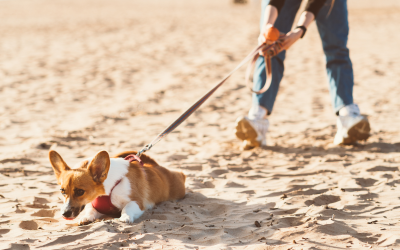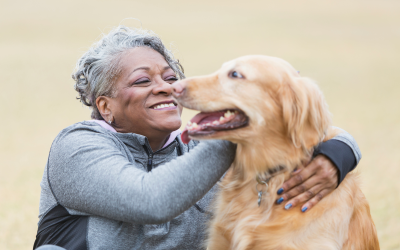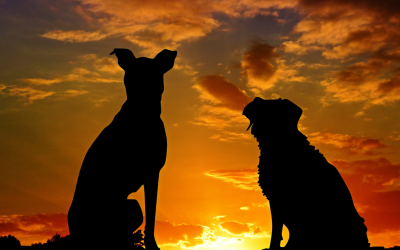First of all, congratulations! If you’ve stumbled on this article, you’re undoubtedly a new puppy parent who’s trying to build a life with your new puppy and get them started on the right paw!
There are a lot of things to think about and learn in these initial days, from choosing a food to finding a vet to learning the best way to clean urine stains in your carpet. But aside from general canine care, you’ll also need to start learning about training your new four-footer.
I’ll help you get started by presenting a timeline that outlines what kinds of things you’ll want to be teaching your dog during different time periods.
0–8 Weeks: Learning from Mom

Newborn puppies are blank slates – they don’t come with very much pre-loaded software. But they start learning about the world and how to be a dog incredibly quickly.
During this time, new puppies learn very simple things like where to find food and warmth. They also enjoy their first social interactions – primarily with their mother, brothers, and sisters.
This is a critical time period for new puppies, and they shouldn’t leave their mom’s side very much during the first 8 weeks of life. That’s part of the reason most dogs aren’t made available for adoption or purchase until they’re 8 or 9 weeks old.
However, if you are present during this time, the only thing you’ll really want to do is interact with your puppy gently. Give them gentle pets and cuddles, and allow them to explore the world while keeping them safe.
8–10 Weeks: First Days Home

Once your new pup has reached 8 to 10 weeks of age, they’re ready to come home with you.
There isn’t a ton of actual training to do during this time – your primary goal is to build trust and security with your new pooch. But you also want to start helping your dog learn how to feel safe when they’re away from you for brief periods of time. This will help prevent separation anxiety issues from manifesting later on.
There are, however, two basic training lessons you can start teaching at this time: name recognition and house training.
The former is simple enough – simply say your dog’s name a lot and ensure that good things (scritches, treats, trips outside) happen when they respond. In other words, say “Cocoa!” in a soft, high-pitched voice. When Cocoa looks at you or trots over, give them plenty of pets and praise.
House training will take time for new pups to learn, but you can start during this time period. The most important thing is that you do not allow your dog to poop or pee inside – at all. By simply building a mental connection between potty breaks and the great outdoors, you’ll make house training much easier over the long run.
This essentially means you’ll want to keep your puppy in a crate whenever you aren’t actively supervising them. When you take them out of the crate, head right outside, where they’ll hopefully relieve themselves. Then, you can offer food and water or play for a brief time. Afterwards, go back outside for another potty break, and then put them right back in the crate.
Lather, rinse, and repeat, and your pup will start to get the hang of things.
Above all else, remember that your pup is having to learn a lot right now, and they’re still quite young. So, keep things positive, avoid overstimulating them, and provide plenty of time for puppy naps and rest.
10–16 Weeks: Socialization Sweet Spot

Puppies between 10 and 16 weeks of age (give or take) are ready to start learning some basic cues and skills. This is actually when things start to get pretty fun!
Your pooch should be starting to get the hang of poopin’ and peein’ outside (though accidents may still occur), but you’ll want to continue solidifying these habits. So, stay vigilant, and continue to use the crate when you can’t actively supervise your pup.
This is also the time when you can start training your dog to do basic things like sitting, coming when called, and even dropping or leaving things when cued to do so. You’ll also want to introduce your dog to the leash and start taking leashed walks around the yard at this time.
But perhaps most importantly, the 10- to 16-week time period is a critical socialization window. You’ll want to expose your puppy to a lot of different people, places, sounds, smells, and surfaces during this time. This will help them avoid fear and anxiety in the future.
It can also be helpful to introduce your puppy to other puppies and dogs during this time period, but extreme care is required. Your pooch will still be receiving some of their initial vaccinations during this period, so they won’t yet be fully protected from many canine illnesses and parasites. So, discuss the issue with your vet and be sure that you don’t allow your pooch to be exposed to other dogs who may get them sick.
4–6 Months: The Teen Pup Begins

By the time puppies are 4- to 6-months-old, they’re starting to enter their early adolescent period. This can be both fun and challenging. On the plus side, your pup’s brain will have developed enough to really start learning some cool things. But on the flip side, they’ll likely start testing boundaries.
Dealing with this is generally pretty simple (if occasionally frustrating): You’ll simply want to remain positive and patient but firm, establish and maintain boundaries, and provide plenty of activity and enrichment to help prevent bad habits from developing.
As for the fun part, you can start teaching your dog more advanced skills, such as loose-leash walking, staying and waiting until released, and games like “find it!” You will also want to start working on any problematic behaviors that arise, such as jumping up on people or chewing things they shouldn’t.
This is also a prime window to start working with a trainer or even attending structured classes.
6–12 Months: Adolescence

There’s no way to sugar coat this, so I’ll just say it: Puppies in late adolescence can be a little trying.
Their hormones start kicking in during this time period, and they may start pushing boundaries even further than they did during their early adolescence. They may also start exhibiting behaviors like selective listening, leash pulling, and nuisance barking.
So, it is important that you continue to enforce healthy boundaries. Employ consistent routines and rules, and be sure to conduct regular (daily if possible) training sessions. And above all, stay patient and positive while working through these issues with your pupper.
But there are also wonderful aspects you’ll get to enjoy during this time, as your pup will really start to be able to pick up advanced skills. You can start training your dog to ignore distractions while training, and you can work on things like advanced leash manners. For example, you may want to start training your dog to stop and sit when you reach key points in your daily walk (such as at the end of the sidewalk).
12–18 Months: Young Adult Refinement

By the time your doggo reaches 12 to 18 months, they should be pretty well trained. They should certainly be able to do things like sit, lie down, and come when called. They should also understand the basics of your daily schedule, so they can anticipate the things you’ll do in a typical day.
But you’re certainly not done training them – you never will be. You must continue to train your dog, so they can practice the behaviors and skills you’ve taught them. You also want to polish these skills and work to improve them. This is especially important for things like leash manners and social interactions.
And assuming your vet gives you the green light, you can start engaging in more advanced things, such as agility trials or canine sports.
Get Training Help When You Need It!

As you can see, training a puppy is not a quick process – it’ll take at least a year, and you’ll want to continue training your new pupperino for the rest of their life.
Just understand that you will undoubtedly run into bumps in the road. Challenges are inevitable.
My advice? Don’t sweat it. Every pet and pet parent experience issues. That’s just part of the pet-parent gig.
Remember to be patient with your pooch, and keep a positive attitude. But most importantly, reach out for help when you need it (and the earlier, the better). I’d be happy to help you and your pupper overcome the training obstacles you are facing, so you can enjoy a more harmonious life together.
Head over to my contact page and tell me a little about your puppy and the problems you’re experiencing. I’ll get right back to you with a plan and outline the steps we can take to move past them.





Recent Comments